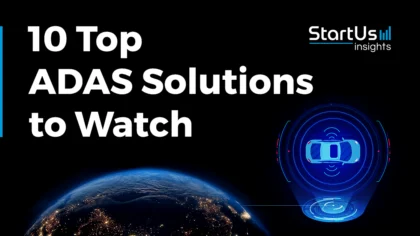The digital transformation in the mobility industry is in full swing, leading many companies to seize mobility as a complementary business model to their core competencies. While autonomous, shared, and electric vehicles are the best-known breakthroughs in mobility, they are far from being the only ones. Innovations such as smart traffic management systems, connected vehicle ecosystems, and advanced mobility-as-a-service (MaaS) platforms are also revolutionizing the industry.
These developments enable seamless integration of various transportation modes, enhance safety and efficiency, and reduce environmental impact. As a result, companies are exploring diverse opportunities to innovate and redefine the future of mobility.
This article was last updated in July 2024.
Dive into Our Data-driven Mobility Innovation Map
At StartUs Insights, we thoroughly analyzed 8.000+ startups to identify emerging technologies bound to impact this industry in the coming years. As we make a point to provide you with actionable insights based on actual startup activity, our research is backed by our proprietary AI- and data-driven innovation scouting approach. Let’s take a look at the key innovation areas in the mobility industry:
Ready to explore all 8000+ Mobility Startups & Scaleups?
Connected Car
Through the integration of the Internet of Things (IoT), connected cars are capable of providing valuable services to drivers and relevant information to companies. As connected cars transform into viable sources of data, they enable predictive and preventive maintenance tools (think on-board diagnostics (OBD)). Taking this concept further, vehicles can be equipped with sensors and electronic control modules, vehicle-to-vehicle (V2V), and vehicle-to-infrastructure (V2I) communications, making them sufficiently aware to avoid accidents or call emergency services in the event of an accident.
Big Data
For mobility companies, big data produces a great amount of data through features like diagnostics, user experience tracking, and driver assistance systems – currently estimated to be situated at an impressive 13€ billion. What is more, big data provides the necessary information for the development of emerging technologies and – in collaboration with predictive analytics or machine learning – proves to be effective in planning maintenance and managing transport networks.
Shared Mobility
Shared mobility offers a vast variety of opportunities ranging from car- to bike-, ride- and scooter-sharing among others. Car-sharing alone is expected to be responsible for 4.7€ billion in annual revenues by 2021 with Europe dominating this field. This results in manufacturers changing their mission statements by incorporating new business models or providing mobility services themselves.
Looking for Specific Mobility Innovation Trends?
Augmented Reality (AR)
Much progress has been made in Augmented Reality in recent years with applications like head-up displays currently being perfected. To date, they are capable of presenting warnings, alerts, and safety aids on invisible screens that are embedded in the vehicle’s windshield. But AR is not limited to ground vehicles alone – as aircraft strive to achieve greater speed, companies can consider the complete exclusion of windows as a means of attaining sturdier planes, capable of handling such speeds.
Lightweight Materials
Innovative technologies also offer advancements to the manufacturing side of mobility: Trading the steel in a vehicle’s body with a lighter alternative such as carbon fiber or other advanced materials, reduces consumption significantly. While these materials reach the weight requirements, they do not sacrifice safety in exchange. The implementation of lightweight materials is soon to come, while over a medium timespan, 3D Printing (or Additive Manufacturing) is expected to play a key role in improving the process of designing and assembling vehicles, leading to an overall greater performance.
In-Vehicle Services
Though advanced infotainment (or next-gen infotainment) in cars is not yet used to its full potential, it is estimated that a value of 5€ billion per minute can be created – conditional that all passengers access mobile media content during the average 50 minutes per day spent traveling. This creates an opportunity for broadening the target group for both on-demand media services, e.g. Netflix or Amazon as well as a space for further business model diversification for OEMs and Tier suppliers. Moreover, once autonomous vehicles are the norm, they will be skilled to pick up deliveries while on their way to passengers thus further increasing the comfort provided by mobility companies.
Mobility as a Service (MaaS)
MaaS offers consumers the possibility of accessing a variety of vehicles by using the same digital platform rather than just car-sharing or another form of vehicle sharing. This creates the space for multimodal transportation platforms allowing travelers and commuters to optimize their trip by benefiting from different types of transportation. Through exclusively using their smartphone and an app, consumers are empowered to handle all aspects of their journey – from planning to payment.
Autonomous Vehicles
In 2012, the laser sensors used in Google’s autonomous cars cost a staggering 62.000€ while three years later, the price dropped to a mere 6.200€ leading to the overall cost of mass production for autonomous cars becoming much more competitive. Currently, it is still unknown when autonomous cars will enter the mainstream due to the existing technology gap and the regulatory framework. However, we can already see applications in public transportation and on-demand services. In the future, driverless cars will contribute to traffic optimization and passenger safety. Meanwhile, the automotive industry takes a step in between by introducing advanced driver assistance systems (ADAS).
Meet Some of the Disruptive Mobility Startups
- Established in 2015, PACE has emerged as a leading entity in the European FinTech landscape, specializing in mobile payment solutions tailored for gas station services. The “Connected Fueling” platform by PACE introduces an extensive range of services that include the digital transformation of fuel cards and smooth integration with various partner applications. This innovation allows for mobile payments to be made directly at the pump using smartphones, smartwatches, or even through the vehicle’s infotainment system, all supported by the advanced PACE pay@pump application known as “PACE Drive“.
- British FiveAI accelerates the development of autonomous vehicles by creating software relying on machine learning to achieve full autonomy. High-resolution cameras, LIDAR, IMS, radar, ultrasound, audio, and GNSS are used to understand the car’s environment.
- Swiss startup WayRay works on the implementation of augmented technologies in vehicles. By developing holographic navigation systems, they support advances in connected cars. In 2017, WayRay was the first to introduce a holographic AR infotainment system aimed at self-driving cars.
- French Heetch targets people who use public transport during the day but are in need of a taxi at night. The startup offers a ride-sharing alternative to taxis, brought to life specifically to address mobility needs late at night.
Explore Emerging Mobility Startups & Technologies
As this article outlines, disruptive innovation in the mobility industry is already at work, reshaping the way of transportation. However, the eight innovation areas mentioned are but a few that impact the industry. Sensoric, Artificial Intelligence, Virtual Reality, Gamification, and Cyber Security are all technologies to be reckoned with – and OEMs, Tier suppliers as well as mobility companies aiming to maintain their pole position are well advised to integrate them early on.










